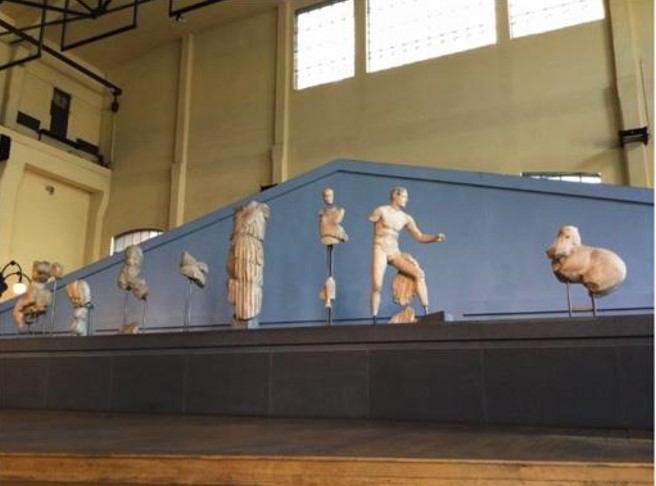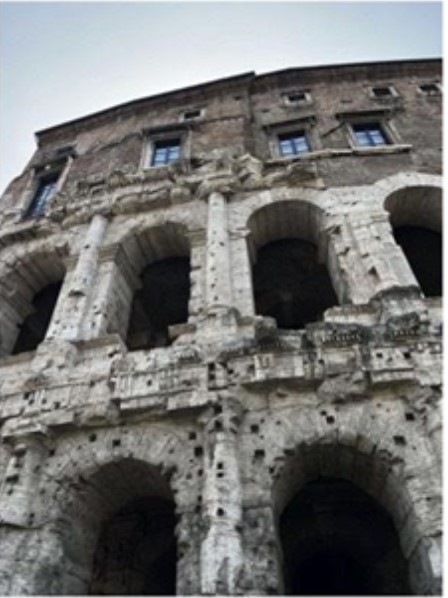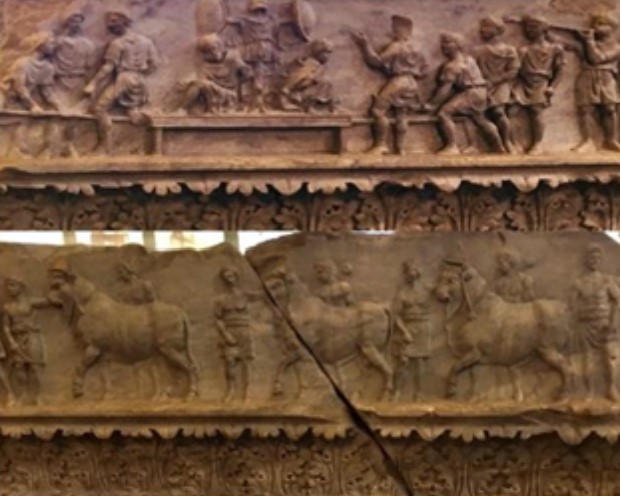Tags
Alex Eckhart, BGSU, BGSU History, BGSU Study Abroad, Casey Stark, Jo Enger Arthur Scholarship for Study Abroad, Roma Aeterna, Rome, Temple of Apollo Sosianus, Theater of Marcellus, Undergraduate
By: Alex Eckhart, BGSU Roma Aeterna 2023 Student
Within the Campus Martius in the northern area of Rome in the former Circus Flaminius lies the Theater of Marcellus. Construction on the theater was begun by Gaius Julius Caesar as a rival to the Theater of Pompey in the southern section of the Campus Martius, but it was not completed until 13 BCE by his successor and adopted son, Augustus. Augustus dedicated the massive structure to his nephew and son-in-law Marcus Claudius Marcellus, who had been his heir until his unfortunate death at the age of 19 in 23 BCE. On the Res Gestae Divi Augusti (Deeds of the Divine Augustus), the official autobiography carved into columns that Augustus had built that proclaims all of his victories and projects for the people of Rome, it says, “I built the theater adjacent to the temple of Apollo on ground in large bought from private owners, and provided that it should be called after Marcus Marcellus, my son-in-law” (Augustus and Bushnell 1998, 21). In order to build such a massive amphitheater, the Temple of Apollo Sosianus was moved several meters away from its original location. The theater is estimated to be able to hold anywhere from 11,000 to 40,000 people, and was in a prime location between the Circus Flaminius and the temple, making it one of the most important amphitheaters in Rome (Claridge et al 2010, 243). It would hold games and festivals for the people, including the Secular Games, which was one of the ludi (Roman celebrations) that involved games and sacrifices. These games were annual, and were held in the amphitheater several years before it had been officially inaugurated. Another of the ludi, the Ludi Apollinares, was held at the nearby Temple of Apollo Sosianus.
Over time, the theater has been used for several different purposes. After it declined in popularity due to the rising interest in gladiator fights held at the Colosseum, it fell into disuse. It was restored by both Vespasian and Alexander Severus, but was pillaged in the fourth century for materials to be used on the restoration of the Ponte Cestio, or bridge of Cestius that connects Rome to Tiber Island (Barber and Macadam 2020, 443). This was a common practice, as it was cheaper to pillage an existing building that was not in use, rather than import new materials. This is the case of many ancient buildings, including the Colosseum. The porticus, a covered colonnade that would have been a part of the amphitheater and most likely held temples to Diana and Piety that were displaced by the building of the theater, began to be taken apart for its stone in order to repair the Bridge of Cestius around 365 or 370 CE (Claridge et al 2010, 244-245). The stage building seemed to have lasted until the 5th century CE, and the colonnaded hall was still standing in 1575. In the present day, there are apartments built on the top of the remaining third of the arcade that modern Romans live in.
The Temple of Apollo Sosianus was very closely related to the theater, with there being some speculation on a connection between drama and cult in ancient Rome (Bergman et al 2012, 8). Many theaters in the Italian peninsula were built on or near cult sites, although the connection between the Theater of Marcellus and the Temple of Apollo is not fully clear. The temple had been rebuilt and expanded by Gaius Sosius by 34 BCE, and is referred to in the modern world as the Temple of Apollo Sosianus. The reconstruction of the temple by Sosius was part of the Apollo-related propaganda that Augustus had begun in 36 BCE with his construction of the second temple on Palatine Hill. Each man used the god for his own purpose. Augustus wanted to begin to cement his place as divine princeps (or ruler) of Rome while Sosius used Apollo as a supporter of Marc Antony and of the Republic. After the battle of Actium, however, Augustus attributed his victory to Apollo’s favor and the idea of the god supporting the Republic quickly vanished (Freyburger-Galland 2009, 22). After this, Apollo would become the god of the Principate and of its victory. It is also speculated that the temple was not, in fact, fully restored by Sosius. Within the temple, there is a surviving frieze that depicts a battle between Romans and what appears to be northern barbarians. This would not be something that Sosius would have added, and it is not likely that it would have been a part of the temple beforehand. In 34 BCE, when the temple was said to have been restored by Sosius, he had been awarded a triumph for a battle victory in Judea. To restore the temple, then, would have been a demonstration that Sosius, and by extension those he supported, were attributing the victory to Apollo and showing his favor for them. However, the frieze shows a triumphal procession from a battle against barbarians, not Jews. There are three bulls being led to sacrifice as well as captured barbarians and trophies such as armor (Fig. 1). It would be entirely possible that Augustus himself would have finished the restorations and added this frieze, because in 23 BCE he celebrated a triple triumph for several victories against the Germanic tribes (Claridge et al 2010, 246-247). For Augustus to have completed the repairs while also having his own Palatine temple would mean that he both had the favor of the people and of the god. Public works projects such as the temple restoration would have provided a display of wealth to the people of Rome, and shown how dedicated Augustus was in service to Apollo. It can also be argued, however, that the barbarians are meant to be more ambiguous and represent the triumph that Sosius had for his victory in Judea. However, both men celebrated triumphs for victories against foreign peoples, and in the Deeds of the Divine Augustus Augustus says that he placed war spoils in several temples, including that of Apollo (Augustus and Bushnell 1998, 24). While this does not necessarily mean that he restored the temple, he certainly had some influence over the temple.
Prior to Augustus, the Temple of Apollo had a very long history. Before there was a full temple built, the Circus Flaminius, also known as the Flaminian Meadows, held the Apollinare, a shrine to Apollo that was outside of the city walls. This cult site is mentioned in Livy’s History of Rome, describing how the Senate held a meeting at this location around 449 BCE because the members of the Senate were voting on giving the consuls a triumph. They protested against holding the meeting within the city due to the number of soldiers, believing that the military may be used as an attempt to intimidate them into agreeing to the triumph (Livy 3.63.6). The temple in its initial form was constructed around 431 BCE during the time of a great plague. As the god of both plague and healing, building a temple to Apollo would have been one of the first things the people would have done. The temple itself was dedicated to Apollo Medicus, the healer Apollo, in 433 BCE by the consul Gnaeus Julius Mento, the ancestor of Gaius Julius Caesar (Claridge et al 2010, 245). According to Livy, Mento had dedicated the temple without consulting the other consul, Titus Quinticus Poenus Cincinnatus, who was away at war. When Quinticus returned, he was angry that Mento had dedicated the temple, but when brought before the Senate nothing came of it (Livy 4.29.6-7). The temple was rebuilt several times prior to its restoration by Sosius, once after the Gallic sack of Rome in 390 BCE and possibly again in 179 BCE. The final restoration in the first century BCE had outer Corinthian columns on the temple’s porch, carved with laurel and elaborate flowerheads. When the temple’s front was excavated, fragments of a triangular pediment depicting an Amazonomachy, a battle between Greeks and Amazons were found (Fig. 2). This would have been imported from Greece, as the statues have been dated to the mid fifth century BCE, hundreds of years before Sosius began his restoration (Claridge et al 2010, 246). The interior of the temple was once beautifully decorated, with colorful marble on the inner cella and numerous marble statues that all related to Apollo, including the Muses, his twin sister Diana, the children of Niobe, and many of Apollo himself.

Today, the visible parts of the outer curved arcades of the Theater of Marcellus represent only a third of its original circumference. The decorative travertine that would have been on the facade of the building has been long stripped away, leaving only the rough tufa, cement, and brick exposed. The Temple of Apollo has only three columns on a small base. Supposedly, the height of the reconstruction is accurate to when Sosius rebuilt it, but there is very little indication of the size of the original base (Claridge et al 2010, 245). The area around this section of the Campus Martius has been built up since the medieval period, making it difficult to imagine the sheer size and grandeur of the beautifully decorated buildings. Any color that would have been in the temple is completely gone, taken by people who were using it to build up Rome. Despite its state of ruin, this area of the Campus Martius remains an incredibly important location in the history of Rome, from its beginning as a sacred space to the cult of Apollo to its use for games and festivals.
Works Cited
Augustus. The Deeds of the Divine Augustus. Translated by Thomas Bushnell. 1998. http://classics.mit.edu/Augustus/deeds.html.
Barber, Annabel, and Alta Macadam. Blue Guide Rome. 12th ed. N.p.: Blue Guides, 2020.
Bergman, Bettina, Joseph Farrell, Denis Feeney, James Ker, Damien Nelis, and Celia Schultz. “An Exciting Provocation: John F. Miller’s ‘Apollo, Augustus, and the Poets.'” Vergilius 58 (2012): 3-20. JSTOR.
Claridge, Amanda, Judith Toms, and Tony Cubberley. Rome: An Oxford Archaeological Guide. 2nd ed. Oxford: Oxford University Press, 2010.
Crawford, Agnes. Pediment sculptures from the temple of Apollo Sosianus. Parian marble. 2015. Photograph. http://www.understandingrome.com/2015/04/16/moving-mountains-a-geological-map-of-empire-at-the-centrale-montemartini/.
Freyburger-Galland, Marie-Laure. “Political and Religious Propaganda between 44 and 27 BC.” Vergilius 55 (2009): 17-30. JSTOR.
Frieze with a Triumphal Procession. Photograph. https://www.centralemontemartini.org/en/opera/fregio-con-processione-trionfale.
Livy. History of Rome. Translated by John Yardley, B. D. Hoyos, and John Briscoe. Cambridge, MA: Harvard University Press, 2017.
Small, Ian. The Theater of Marcellus. May 2023. Photograph.
The three re-erected columns. Photograph. https://www.wikiwand.com/en/Temple_of_Apollo_Sosianus.



